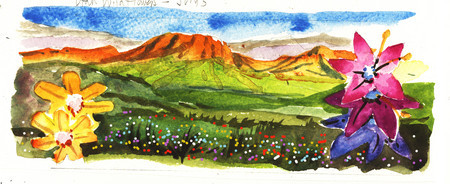Southern Utah’s high country explodes with color during wildflower season
Nature creates bountiful gardens in Southern Utah's high country during the short summer season, usually peaking in July. Springtime arrives late atop the 10,000-foot plateaus. Plants hasten to produce flowers and seed for future years in the brief weeks between the last of snow melt in May or June and the return of autumn in September.
Plants in profusion assure that some of their seeds will survive the insects, birds and animals that feast upon them, as well as the myriad disasters nature may inflict upon them. Thus millions of bright blossoms greet high country visitors this season, perfuming the pure mountain air and coloring it with their pollen.
Those outdoor enthusiasts intrigued and beguiled by mountain wildflowers can hardly do better than explore the roads and trails near Cedar Breaks National Monument. A network of highways on the Markagunt Plateau near Cedar Breaks east of Cedar City makes high country accessible and provides many flower-strewn scenic drive. When you enter Cedar Breaks, expect to pay a $4 fee unless you hold one of the federal parks passes.
Drive north from Las Vegas into Utah on Interstate 15. Access the Markagunt Plateau from Cedar City on Highway 14 or from Parowan on Highway 143, the road to Brian Head village and winter sports area. Either route takes you to the high country in abut four hours.
The rim drive in Bryce Canyon National Park at the edge of the Paunsaugunt Plateau gives spectacular views of the fiery-hued, eroded gorge on one side of the road and flower-starred meadows on the other, particularly at its high, southern end. Other high plateaus with fir and spruce forests interspersed with flower meadow in Southern Utah remain less accessible, reached only by graded forest roads or trails best explored on foot on horseback or by all-terrain vehicles where that is permitted.
Cedar Breaks National Monument celebrates its Fourth Annual Wildflower Festival through July 19. Park personnel and volunteers specializing in wildflowers will be on hand daily at park headquarters from 10 a.m. to acquaint visitors with the dozens of flower species now in bloom.
They guide popular wildflower walks into adjacent areas daily at 10 a.m. and 1 p.m. Peruse the electronic display of wildflower photos now operating in the visitor center. During the festival, a 10 percent discount applies to all books and other items in the bookstore related to wildflowers.
Photographers interested in polishing their skills at wildflower photography have opportunities to join workshops run by experts during the Cedar Breaks festival. Inquire about registering for a free workshop on Saturday by calling the monument at (435) 586-0787, ext. 39, or the Cedar City office at (435) 586-9451, ext. 50. The Zion Canyon Field Institute, which operates the Cedar Brakes bookstore, schedules a photo workshop on July 13. To inquire about fees and registration, call the Institute at (435) 772-3264.
Pick up park service brochures at Cedar Breaks to help you identify the flowers you will see. A guide to Rocky Mountain wildflowers will help, but some flowers in the area occur only in Southern Utah. Look for a color-illustrated field guide specific to the region while you are in the visitor center.
Even if you never get out of your car as you cruise area roads, you will spot plenty of wildflowers. Those that you see in passing command attention with bold colors or profusion of blossoms. When you park safely off the travel lanes and get out of your car for a stroll away from the pavement, you discover even more kinds of flowers in bloom.
Step carefully to avoid crushing tiny plants and resist the urge to pick any flowers.
Several short trails within Cedar Breaks National Monument reveal different flowers as they offer plants different environments than the open meadows. Just outside of Cedar Breaks 11,300-foot Brian Head lies above timberline. Along its short trail from the parking lot to an observation shelter look for a profusion of alpine flowers found nowhere else in the area borne atop dwarf plants.
Margo Bartlett Pesek's column appears on Sundays.






















